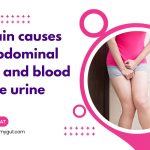Stabbing Pain in The Left Lower Abdomen: 8 Causes & When to Worry.
Our content is not intended nor recommended as a substitute for medical advice by your doctor. Use for informational purposes only.
Common causes of Stabbing lower left abdomen pain include:
- Simple colon spasms.
- Diverticulitis.
- Left abdominal muscle strain.
- Left inguinal hernia.
- Left ovarian cyst or tumor.
- Left tubal ectopic pregnancy.
- Left ureter pain.
- IBD.
1- Simple colon spasms (Constipation or gas build-up).
Abdominal pain is one of the most frequent complaints. The character, site, and degree of pain give us an idea about the possible cause.
When it comes to stabbing pain in the left lower abdomen, the colon is the first to come to mind.
Before rushing into the worst scenarios of pain, you have to think in order of what is common.
Colon pain is usually crampy in nature, but simple gas build-up or colon pain may cause stabbing lower left abdominal pain.
If you suffer from constipation (acute or chronic), you are more likely to experience pain in the lower left abdomen. The pain can be stabbing in severe cases or straining.
Characters of colon pain in the lower left abdomen:
- It is usually in the form of colics but can be stabbing.
- Associated with a change in stool form (particularly constipation or hard stool).
- Straining to have a bowel movement. The stabbing pain increases during straining.
- Passing stools can result in relief of the stabbing pain in the left lower abdomen.
- Causes of colon pain other than constipation can also occur. For example, IBS pain can occur in the left lower abdomen.
- Usually, no signs of severe inflammatory process: No vomiting, no nausea, the pain is not related to movement.
- The pain is related to food. And it can be associated with colics and distension elsewhere in your abdomen.
2- Diverticulitis.
The most common site of diverticular pain is the lower left abdomen. A colon diverticulum is a sac or pouch in the wall of the colon.
The presence of diverticula is common and increases with age. For example, the prevalence of diverticulosis is less than 20% at the age of forty. Then, its prevalence increases with age to reach 60% at the age of 60 (ref).
Commonly, the diverticula have no symptoms. However, they can get inflamed, form abscesses, or even become perforated.
The inflammation or abscess formation of the colon diverticula is called “diverticulitis.”
Symptoms of diverticulitis include:
- Stabbing lower left abdominal pain. It is the most common symptom due to the involvement of the sigmoid colon.
- The pain is usually constant, lasts for days with a gradual increase in its intensity.
- Nausea and/or vomiting.
- Low-grade fever can also occur.
- A sense of tender mass in the lower left abdomen (in 20% of patients with acute diverticulitis).
- Severe tenderness or gardening in the lower left abdomen.
- In severe cases (with access and perforation): low blood pressure and shock may be present.
- Change in bowel habits: constipation occurs in about 50% of patients with acute diverticulitis, and diarrhea in 25-35% (ref).
Risk factors of acute diverticulitis:
- Low-fiber diet.
- High fat and meat in the diet.
- Physical inactivity.
- Obesity.
- Smoking.
- Older age.
What to expect from diverticulitis:
- The incidence of complications such as abscesses, perforation of the colon, fistula formation is common (up to 25% of cases are complicated). (ref)
- Diverticulitis is a serious medical condition. it requires urgent medical help.
- Your doctor may require abdominal imaging (CT abdomen) and some blood work to confirm the diagnosis.
- Usually, colonoscopy has no role in acute diverticulitis.
- Some patients may need hospital admission and in-patient treatment.
- The treatment usually includes antibiotics and restriction of diet.
- Major complications may such as abscesses or perforations requiring surgery.
Learn more about acute diverticulitis as a cause of left lower abdomen stabbing pain.
MORE: Diverticulitis 101: Symptoms, Treatment, & what to eat.
3- Musculoskeletal pain.
One of the most common and simplest causes of stabbing pain in the lower left abdomen is muscular pain.
If you have abdominal muscle strain, you may feel stabbing pain or tenderness every time you move or strain.
Abdominal muscle strains are usually caused by vigorous strain, workouts, carrying heavy objects, or prolonged heavy physical efforts.
Symptom of abdominal muscle strain (in the lower left abdomen):
- Sharp or stabbing pain (usually starts suddenly at the moment of strain and continues).
- Fixed in intensity, increases greatly by moving, bending, or straining.
- It may affect your walking or movements in general.
- Sometimes, you may experience swelling or bruising at the site of strain.
Sharp left lower abdominal pain caused by muscle strain usually resolves within a few days.
Some tips to help its relief:
- Cold therapy with an ice pack.
- Heat therapy with a heating pad.
- Compression by wearing an abdominal binder.
- Rest, avoid vigorous exercise.
- In some cases, you may need some analgesics such as Ibuprofen (Advil). But first, you have to consult your doctor or nurse to confirm the diagnosis.
4- Hernia.
Left inguinal hernias are common. About 4% of those who are aged over 45 years experience abdominal wall hernias (ref).
A hernia is a bulge of a part of your intestine or colon through an abdominal wall defect.
Symptoms of a left inguinal hernia include:
- A bulge or swelling in the left groin.
- The swelling can be small at first and present with sharp lower left abdominal pain.
- The swelling becomes more obvious when you stand upright.
- The swelling increases in size with coughing or straining.
- A burning or stabbing pain sensation in the left lower abdomen is common.
- With the indirect type of inguinal hernia, the swelling may extend to the scrotum in males.
Consult your doctor if you notice any groin swelling. The treatment is mainly surgical closure of the defect.
5- Ovarian cyst or tumor.
The left ovary can be a source of lower-left sharp abdominal pain in females. Several conditions affecting the left ovary can lead to such sharp pain:
- Left ovarian cyst.
- Left ovarian tumor or cancer.
- Ovarian pain is caused by endometriosis.
- A pelvic inflammatory disease affecting the left side.
Ovarian cysts are very common in females, especially during the childbearing period. Learn more about ovarian cysts and other causes of ovarian pain HERE.
Symptoms of left ovarian pain:
- Dull or sharp pain in the lower left abdomen.
- Menstrual irregularities.
- Nausea or vomiting.
- Pain during intercourse or bowel movements.
- Feeling full after eating small amounts.
- Bloating.
- Unexplained weight loss (with ovarian cancers).
6- Left tubal pregnancy.
Ectopic pregnancy is more common than you think. Approximately one in every 40 pregnancies is ectopic, according to the CDC statistics (ref).
About 96% of the cases of ectopic pregnancy occur in the fallopian tube (ref).
The first symptom of an ectopic left tubal pregnancy is pain in the left lower abdomen.
The pain may become sharp as the pregnancy grows or due to the development of complications such as rupture of the tube.
Symptoms of ectopic left tubal pregnancy:
- Sharp left lower abdominal pain.
- Vaginal bleeding.
- Absence of menses (amenorrhea).
- Pain on moving or bending.
- Positive preganacy test.
- In severe complicated cases, fainting, low blood pressure, severe abdominal pain, and gardening.
7- Left ureter pain.
The kidney delivers urine to the urinary bladder through the right and the left ureters.
You may get ureteric pain due to the passage of a stone or due to its obstruction for any cause.
Ureteric pain is different from kidney pain. Kidney pain is usually located in the loin area towards the back.
The ureteric pain can present with both loin pain and sharp lower left or right abdominal pain. And can extend to the inner side of the thigh and the scrotum (in males).
The pain from the ureter is extreme, sharp, and described as the worst pain ever (ref).
It starts suddenly, with intense flank colic that extends to the lower abdomen and groin.
It may be associated with a change in the color of urine, nausea, vomiting, or fever.
Learn more about ureteric pain.
8- Inflammatory Bowel disease.
Inflammatory bowel disease is characterized by unexplained inflammation and ulceration of:
- The colon and the rectum (ulcerative colitis).
- The entire gastrointestinal tract (Crohn’s disease).
According to the CDC, about 1.3% of us adults (around 3 million) reported being diagnosed with IBD (ref).
Sigmoid or left colon ulcerative colitis can cause sharp left lower abdominal pain.
Symptoms of IBD include:
- persistent diarrhea.
- Mucus and/or blood in the stool.
- Frank rectal bleeding.
- Sharp abdominal pain: can occur at any site, including the lower left abdomen.
- Generalized fatigue.
- Unexplained weight loss.
The IBD is diagnosed by performing a colonoscopy to visualize the lesions (ulcers) and to take a biopsy.
IBD is a more serious condition than irritable bowel syndrome. It requires medical follow-up and specific treatments.
When to see a doctor?
- The pain is severe and intolerable.
- Presence of blood in the stool or rectal bleeding.
- Presence of fever.
- Severe nausea or vomiting.
- Fainting or dizziness.
- Extreme tenderness on touching the lower left abdomen.
- Unable to walk or move due to the pain.
- If you don’t get better within 24 to 48 hours.
- Evidence-based
- Written by a doctor.

Related Posts:
- 5 Causes of Bubbling sensation in The Lower Abdomen:…
- Stabbing Chest Pain When Swallowing: 5 Causes,…
- 6 Causes of Left Abdominal Pain When Pressed.
- Stomach Pain after Emptying the Bladder: Causes…
- Blood On The Outside Of The Stool: 7 Causes & When To Worry.
- Black Watery Diarrhea: 5 Causes & When To Worry.






